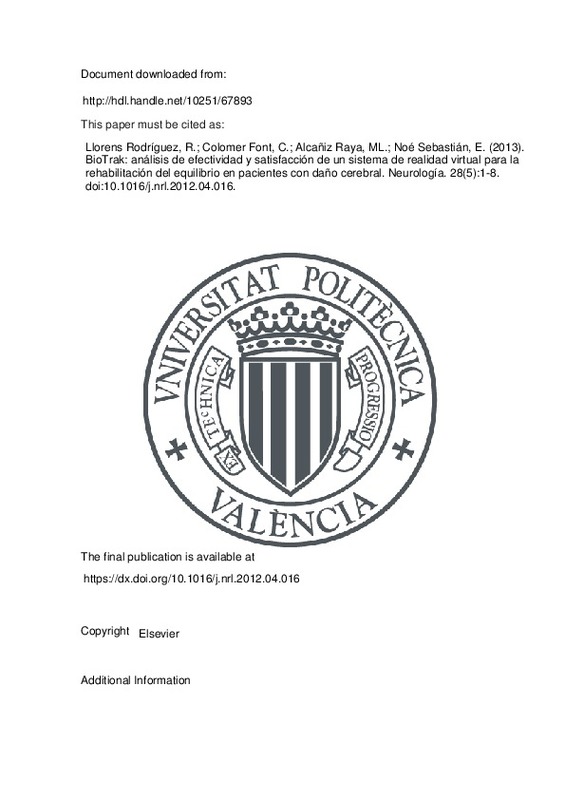JavaScript is disabled for your browser. Some features of this site may not work without it.
Buscar en RiuNet
Listar
Mi cuenta
Estadísticas
Ayuda RiuNet
Admin. UPV
BioTrak: análisis de efectividad y satisfacción de un sistema de realidad virtual para la rehabilitación del equilibrio en pacientes con daño cerebral
Mostrar el registro sencillo del ítem
Ficheros en el ítem
| dc.contributor.author | Llorens Rodríguez, Roberto
|
es_ES |
| dc.contributor.author | Colomer Font, Carolina
|
es_ES |
| dc.contributor.author | Alcañiz Raya, Mariano Luis
|
es_ES |
| dc.contributor.author | Noé Sebastián, Enrique
|
es_ES |
| dc.date.accessioned | 2016-07-20T09:59:35Z | |
| dc.date.available | 2016-07-20T09:59:35Z | |
| dc.date.issued | 2013-06 | |
| dc.identifier.issn | 0213-4853 | |
| dc.identifier.uri | http://hdl.handle.net/10251/67893 | |
| dc.description.abstract | [EN] Objective: To study effectiveness of and satisfaction with a virtual reality-based balance rehabilitation system (BioTrak) for patients with acquired brain injury (ABI). Material and methods: Ten patients with chronic hemiparesis (chronicity > 6 months) following an ABI completed a 20-session programme using the balance reaching-task module of the BioTrak system. All patients were assessed at baseline, at the end of treatment and one month later with the Berg Balance Scale (BBS), the Tinetti Performance-Oriented Mobility Assessment (POMA), and the computerised posturography tool NedSVE/IBV. The posturography study included analysis of sensory indexes, limits of stability and rhythmic weight shift. The usability study was conducted using an ad hoc questionnaire. Results: Repeated measures ANOVA showed a significant improvement in BBS (P < .01), TBS (P < .01), vestibular index (P < .05), and anterior-posterior weight shift (P < .05); a trend in the same direction was also found for medial lateral weight shift (P = .059). The post-hoc analysis revealed significant improvement between the initial and final assessments for BBS, POMA and anterior-posterior weight shift control; gains remained a month after completing the programme. The system showed a high degree of usability in terms of presence, immersion and user-friendliness, and there was a significant absence of adverse effects. Conclusion: Our results confirm the utility of virtual reality systems for balance rehabilitation in this population. Usability data suggest that BioTrak could be adapted for use in multiple rehabilitation settings by a high number of patients. © 2011 Sociedad Española de Neurología | es_ES |
| dc.description.sponsorship | Este estudio fue financiado por el Centro para el Desarrollo Tecnológico Industrial (proyecto TEREHA, IDI-20110844) y parcialmente financiado por el Ministerio de Educación y Ciencia de Espana, ˜ proyecto Game Teen (TIN2010-20187), proyectos Consolider-C (SEJ2006-14301/PSIC), «CIBER de Fisiopatología de la Obesidad y Nutrición, una iniciativa del ISCIII», el Programa de Excelencia PROMETEO (Generalitat Valenciana, Consellería de Educación, 2008-157). | |
| dc.language | Inglés | es_ES |
| dc.publisher | Elsevier | es_ES |
| dc.relation.ispartof | Neurología | es_ES |
| dc.rights | Reserva de todos los derechos | es_ES |
| dc.subject | Balance | es_ES |
| dc.subject | Brain injury | es_ES |
| dc.subject | Rehabilitation | es_ES |
| dc.subject | Stroke | es_ES |
| dc.subject | Usability | es_ES |
| dc.subject | Virtual reality | es_ES |
| dc.subject.classification | EXPRESION GRAFICA EN LA INGENIERIA | es_ES |
| dc.title | BioTrak: análisis de efectividad y satisfacción de un sistema de realidad virtual para la rehabilitación del equilibrio en pacientes con daño cerebral | es_ES |
| dc.title.alternative | BioTrak virtual reality system: effectiveness and satisfaction analysis for balance rehabilitation in patients with brain injury | es_ES |
| dc.type | Artículo | es_ES |
| dc.identifier.doi | 10.1016/j.nrl.2012.04.016 | |
| dc.relation.projectID | info:eu-repo/grantAgreement/MICINN//IDI-20110844/ES/PLATAFORMA INTEGRAL DE TELERREHABILITACIÓN MOTORA, COGNITIVA Y PSICOSOCIAL, MEDIANTE EL USO DE TECNOLOGÍAS TIC E INTERFACES NATURALES (TEREHA) (3%2F5)/ | es_ES |
| dc.relation.projectID | info:eu-repo/grantAgreement/MICINN//TIN2010-20187/ES/ENTORNOS INMERSIVOS Y PERSUASIVOS PARA LA EVALUACION Y ENTRENAMIENTO DE ESTRATEGIAS DE REGULACION EMOCIONAL. APLICACION A LA EDUCACION PSICOSOCIAL EN ADOLESCENTES/ | es_ES |
| dc.relation.projectID | info:eu-repo/grantAgreement/MEC//SEJ2006-14301/ES/NUEVAS TECNOLOGIAS DE LA INFORMACION Y LA COMUNICACION: INTEGRACION Y CONSOLIDACION DE SU USO EN CIENCIAS SOCIALES PARA MEJORAR LA SALUD, LA CALIDAD DE VIDA Y EL BIENESTAR./ | es_ES |
| dc.relation.projectID | info:eu-repo/grantAgreement/GVA//PROMETEO08%2F2008%2F157/ES/Promoción del bienestar a través de las tecnologías de la información y comunicación (probientic)/ | es_ES |
| dc.rights.accessRights | Abierto | es_ES |
| dc.contributor.affiliation | Universitat Politècnica de València. Instituto Interuniversitario de Investigación en Bioingeniería y Tecnología Orientada al Ser Humano - Institut Interuniversitari d'Investigació en Bioenginyeria i Tecnologia Orientada a l'Ésser Humà | es_ES |
| dc.contributor.affiliation | Universitat Politècnica de València. Escuela Técnica Superior de Ingeniería Agronómica y del Medio Natural - Escola Tècnica Superior d'Enginyeria Agronòmica i del Medi Natural | es_ES |
| dc.description.bibliographicCitation | Llorens Rodríguez, R.; Colomer Font, C.; Alcañiz Raya, ML.; Noé Sebastián, E. (2013). BioTrak: análisis de efectividad y satisfacción de un sistema de realidad virtual para la rehabilitación del equilibrio en pacientes con daño cerebral. Neurología. 28(5):1-8. https://doi.org/10.1016/j.nrl.2012.04.016 | es_ES |
| dc.description.accrualMethod | S | es_ES |
| dc.relation.publisherversion | https://dx.doi.org/10.1016/j.nrl.2012.04.016 | es_ES |
| dc.description.upvformatpinicio | 1 | es_ES |
| dc.description.upvformatpfin | 8 | es_ES |
| dc.type.version | info:eu-repo/semantics/publishedVersion | es_ES |
| dc.description.volume | 28 | es_ES |
| dc.description.issue | 5 | es_ES |
| dc.relation.senia | 231200 | es_ES |
| dc.identifier.pmid | 22727272 | |
| dc.contributor.funder | Ministerio de Educación y Ciencia | |
| dc.contributor.funder | Generalitat Valenciana | |
| dc.contributor.funder | Ministerio de Ciencia e Innovación |







![[Cerrado]](/themes/UPV/images/candado.png)

